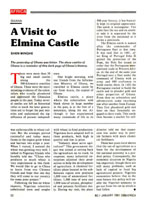The yesterday of Ghana was bitter. The slave castles of Ghana is a reminder of this dark page of Ghana’s history.
There were more than 30 big and small castles along the 500-kilometre coastline of Ghana. These were the incriminating evidence of the colonialists who cruelly plundered and oppressed the Ghanaian people in the past. Today several castles are left as historical relics to teach the later generations not to forget the past miseries and understand the significance of present independence.
One bright morning, with our friends from the Information Ministry of Ghana, we travelled to Elmina castle by car from Accra, the capital of Ghana.
Elmina castle, a place where the colonialists sold black slaves in large number in the past, is at the foot of a mountain, along the sea. Although it has experienced many vicissitude of life in its 500-year history, it has basically kept its original appearance. The castle is rectangular. Two sides face the sea and on another side it is separated by the river from the mainland so it forms a peninsula.
The Elmina castle is named after the commander of Portuguese fleet at that time. It was said that in 1481, after King of Portugal John Ⅱ gained the protection of the Pope, the Holy See issued an order that the Portuguese monopolized trade in Western Africa. At the end of the same year Portugal sent a fleet under the command of Elmina with an army and 600 craftsmen to build castles there. In 1482 the Portuguese started to build the castle and to plunder gold and other properties of Ghana. From then on colonialists and adventurists came swarming one after another from Europe. They first plundered gold and later on they frenziedly engaged in slave trade. This castle then became a market for selling slaves, so the people called it “slave castle.”
After entering, we first visited small prison houses on the two sides of the square. Iron sheets were nailed on the prison gates and there was a relief sculpture of a black man’s head on each dorr lintel. These were prison houses of convicts sentenced to death. Crisscross iron fetters with barbs are on display there. A guide said that if the slaves slightly expressed opposition, they were in fetters.
Being been in fetters, they could not lie down, otherwise the iron crooks would nail their skins and flesh. Therefore, they had to stand up till death.
Then we went to the small yard on the first floor with prison houses around for women slaves. There are two big iron rings on the stone plate of the yard. This was the place for punishing the female slaves. When they were considered to have violated the “laws and regulations,” they were locked upon these two iron rings and were exposed to the hot sun for five hours. Thus many female slaves were tortured to death.
The underground of the castle were dungeons for slaves. It was a ghastly, damp, hot and gruesome place. It was said that the smell of blood and mould irritated the mouth and nose at that time. In the dark, mosquitoes and black flies flew against the face and poisonous insects crawled everywhere. Hundreds of slaves were crowded in one dungeon and tormented by diseases, hunger and cruel punishment. If some of them were ill or wounded, they were thrown into the sea alive. Here we saw a small cavelike a sewer. The guide told us that slaves used to be driven away with leather whips and forced to crawl out. Through a 12-metre long passage they were loaded on the ships and transported to the other side of the Atlantic. In front of such ghastly dungeons, we seemed to hear the slaves’ painful moans, despairing sighs and grievous calls that reverberated with the waves of the Atlantic.
The ground above the dungeons was a place for buying and selling the slaves. They were displayed like animals and sold out there. The customers chose slaves through small windows and they were escorted out one after one.
Finally we climbed to the top of the castle. This historical place bears testimony to the crimes of the Western colonialists who plundered Africa.

Foreign tourists visit Slave Castle on Grey Island, Ghana. XINHUA

The first colonial castle of the Golden Coast (in what is today Ghana).


 Copy Reference
Copy Reference 